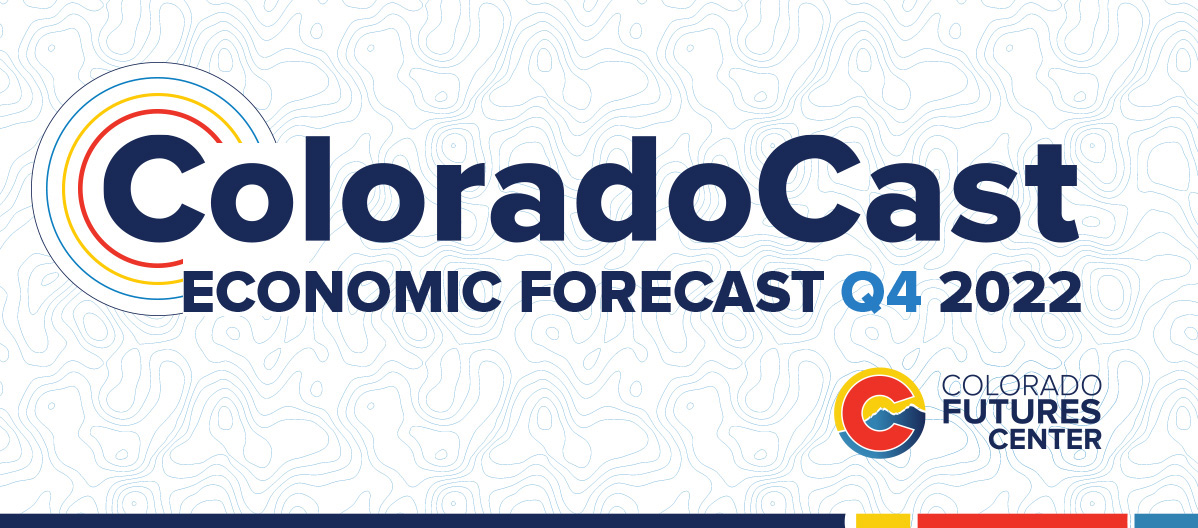
The latest economic forecast from the Colorado Futures Center predicts that the state’s economy will continue slowing in coming months, and that growth may even turn negative for a brief period in early 2023.
Yet the ColoradoCast continues to suggest that the state will avoid a recession as declines in the housing market become moderate and the state benefits from continued strength in the labor market, resilient consumers, and indications at a national level that inflation may be easing.
“While the slight declines in the ColoradoCast for two months in early 2023 were not unexpected, I was relieved to see that they remained modest and short-lived,” said Dr. Phyllis Resnick, lead economist and executive director of the Colorado Futures Center. “This latest forecast continues to support our previous assessments that Colorado’s economy is resilient and is well positioned to weather current headwinds and avoid recession.”
The ColoradoCast forecast shows the state economy retaining positive rates of annual growth through the end of 2022. However, the slowing continues early next year, and the forecast annual rate of growth turns slightly negative in the months of February and March 2023.
Even with the 2 months of predicted modest decline in the economy, the forecast from the Colorado Futures Center, an independent 501(c)(3) organization housed at the Colorado State University System, does not suggest recession. Instead, the slight declines follow a pattern of continued slowing in the economy since the recovery from the pandemic.
A return to slightly positive growth in April of 2023 supports the outlook that any slowdown will be modest and that a recession will be avoided.
The largest drag on the November ColoradoCast is the recent decline in housing markets. The S&P/Case Shiller Co-Denver Index of home prices experienced its largest ever month-over-month decline in August 2022 (1.8% decline). This followed a fairly significant (1.3%) month-over-month decline in July and preceded a month over-month-decline of 1.3% in September – making this the most significant three months of decline in the history of the Case Shiller index. However, housing market declines are forecast to moderate later in 2022 and, significantly, these recent declines follow the two largest year-over-year gains in the history of the index in 2020 and 2021.
The pattern of negative changes in housing prices, coupled with the continued stresses from equity and bond markets, are the primary drivers of the early 2023 forecast for a slight decline in the Colorado economy. With the forecast of moderation in these declines, a modest bounce-back is predicted early in the second quarter. The Colorado economy is further buoyed by continuing strength in the labor market and by resilient consumers, both locals and visitors. In addition, there are indications that inflation, and the Federal Reserve response to it, may be easing through the end of 2022.
The full report is available for download at coloradofuturescsu.org/coloradocast.
About the ColoradoCast
The ColoradoCast is a short-term (approximately six months ahead) economic forecast for the Colorado economy developed by the Colorado Futures Center, a 501c3 organization dedicated to informing about economic, fiscal, and public policy issues impacting community economic health and quality of life. It is designed to forecast a well-known contemporaneous measure of statewide economic activity, the Coincident Economic Activity Index for Colorado, developed by the Federal Reserve Bank of Philadelphia. The Coincident Economic Activity Index includes four indicators: nonfarm payroll employment, the unemployment rate, average hours worked in manufacturing and wages and salaries. The trend for the index is set to match the trend for gross state product.
The ColoradoCast predicts the value and annualized growth rate in the coincident index using six factors: the yield curve measured by the spread between two- and 1o-month treasuries, the risk spread between high-quality corporate and ten-year treasury returns, employment in the employment services sector, home prices as measured by the Case-Shiller index for Denver, initial claims for unemployment insurance, and the value of the Wilshire 5000 stock index. The ColoradoCast is released quarterly and fills within economic forecasts and the importance of understanding short-term economic projections to businesses.
The Colorado Futures Center extends a thank you to Dr. Steven Fisher who collaborated on the initial development of the ColoradoCast model.